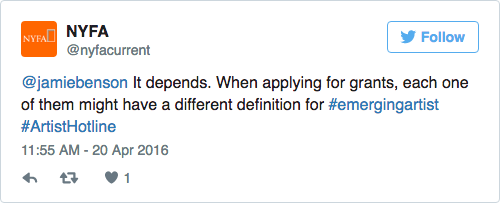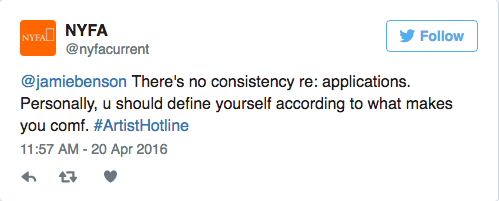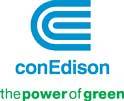Ask #ArtistHotline: Am I an “Emerging” Artist?
As with all aspects of your artistic work, your opinion is the definitive one.
#ArtistHotline is a social media initiative that’s dedicated to resource-sharing and providing advice on navigating the art world. The labels used for art and its practitioners can be especially tricky, and during a previous #ArtistHotline exchange on Twitter, dancer and choreographer Jamie Benson asked about the distinction between an “emerging” and a “mid-career” artist.

Emerging vs. Mid-Career
How do you know whether you’re emerging or not, and when do you reach “mid-career” status? It is hard to tell, mostly because terms like “emerging,” “mid-career,” and “established” can mean many different things.
An emerging artist is usually defined as someone at the early stages of their career. Maybe, as an “emerging” artist, you’re honing your style and have landed some recognition from a critic, but you don’t have commercial representation yet. Or perhaps you’ve published a few poems or short stories, but you haven’t published a book, or you’re a performance artist with a few notable performances and a residency under your belt.
Seems simple, right? Not quite. Julia Halperin, writing for ARTINFO, reached out to scholars, artists, and gallerists to define the term “emerging,” and found the different definitions were “based on every conceivable rubric, from age to exhibition history to reputation.” Artist and writer Roger White offered a definition that captures the elusive nature of the term: “between unknown and overexposed?”
“Emerging” is a label that resists quantification. This ambiguity can feel like a blessing and a curse for an artist trying to secure funding, recognition, or commercial success.
The word “mid-career” is also up to interpretation. It can refer to an artist who’s able to draw on a large body of work, and who has received sustained recognition on a broader scale. Some galleries, though, simply call all artists who have been practicing for more than a decade “mid-career.” With luck, they’ll become established artists, joining the illustrious “cohort of the dominant,” in the words of art historian Terry Smith.

Understandably, these labels make many artists uncomfortable. Some object to the word “emerging” on a practical level, suggesting that branding yourself as “not quite there yet” could be a turn-off for collectors. Many also criticize the idea of “emergence” from an ideological standpoint, claiming the word implies that an artist can be “finished,” that there’s some ultimate point of arrival, and that a life of artmaking is a linear path. And some artists resent the fact that labels like emerging and mid-career are almost always imposed on them by other people, like journalists or gallerists.
This heated debate serves as a reminder on the importance of being in control of your brand; as we discuss in our book, The Profitable Artist, “if you don’t brand yourself, others will do it for you.”
Matchmaker, Matchmaker
If you’re still wondering, though, why such vague labels matter, consider this: being an entrepreneurial artist is all about matchmaking, or finding the opportunities that are a good fit for you. This could mean finding the right writing fellowship, the right travel grant, the right residency, the right gallery, the right open call. One of the most important tips for emerging artists is to apply to as many opportunities as possible, while being conscientious about the guidelines.
As with all aspects of your artistic work, your opinion is the definitive one. But being flexible about how you define and present yourself can help you take advantage of the many opportunities out there for emerging artists. We had this in mind when we answered Jamie Benson’s question during last month’s #ArtistHotline, with some help from the Genesee Center for the Arts & Education:



Begin Your Search
So let’s say you’re ready to start looking for emerging artist opportunities. A great place to begin is NYFA Source, where you can tailor your search based on career stage. To do so, visit: http://source.nyfa.org/, specify the desired award type and discipline, and use the search terms:
Other Criteria – Career Point: Emerging
You could also search by the keyword “Emerging” after choosing the kind of award you’re after.
Study the Guidelines
As you comb through various guidelines, you may run into some with pretty straightforward, strictly defined criteria for emerging artists. As an example, the Emerging Artist Award from the City of Atlanta’s Bureau of Cultural Affairs gives priority to “developing artists 35 years of age or younger AND/OR with less than 5 years of professional experience in their chosen artistic field.”
But you’re also likely to run into guidelines that define “emerging artist” very loosely. These funders probably recognize that “emerging” is a slippery word, but they still want to help the artists who could most benefit from their support. The Jerome Foundation, for example, states that “there is no exact and singular definition of an emerging creative artist. The Foundation seeks to support those artists who show significant potential, yet are under-recognized.” This statement hints at the fact that it can be a smart strategic move to cast yourself as an “emerging” artist. Doing so implies that your unique voice is one that hasn’t been heard yet.
If you’re unsure about whether you fit into the guidelines for a specific opportunity, read the Frequently Asked Questions closely, and, if that doesn’t help, or if they aren’t available, many organizations are happy to answer your eligibility questions. If you’re uncertain about anything, it’s a good idea to ask before you apply.
Tell us what you Think!
Artists, what’s your opinion? Do you think the phrase “emerging artist” should be eliminated from the English language, or does it serve a purpose? Have you ever been stumped by the term in application guidelines, and, if so, what were your next steps? Chime in on this and and other issues around the business of art during our next #ArtistHotline, on Wednesday, May 18, 2016.
Inspired by the NYFA Source Hotline, #ArtistHotline is a new initiative dedicated to creating an ongoing online conversation around the professional side of artistic practice. #ArtistHotline occurs on the third Wednesday of each month on Twitter. Our goal is to help artists discover the resources needed, online and off, to develop sustainable careers. Please join us for the next #ArtistHotline discussion on May 18.
This initiative is supported by the Emily Hall Tremaine Foundation.
– Mirielle Clifford, Program Associate, Online Resource
Images: Benjamin Grasso (Fellow in Painting ‘10), Edifice, 2009, Oil on Canvas; Janelle Iglesias (Fellow in Crafts-Sculpture ‘11), draw back the bow – or kill your darlings, 2010, mixed media installation with scavenged materials




